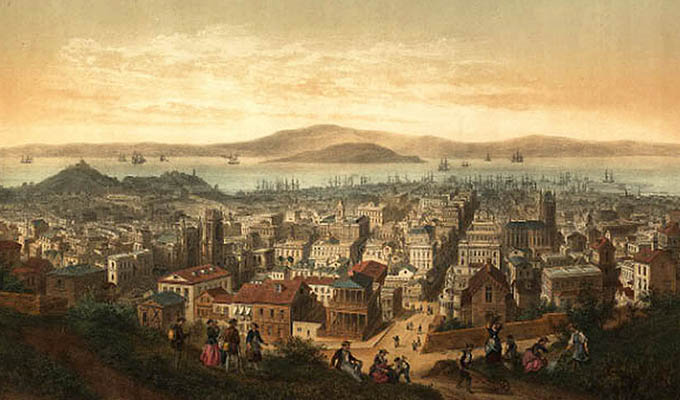Passenger Lists: San Francisco 1800s

SS John L. Stephens
Arrive San Francisco
April 3, 1854
SS John L. Stephens
R. L. Pearson, Esq., Commander
From Panama
Passage
The splendid P.M. steamer John L. Stephens, R.L. Pearson, Esq., commander, was telegraphed immediately after the arrival of the Sierra Nevada, bringing two days later news from the Atlantic States and from Europe.

The Stephens brought up the great U.S. mail of the 6th of March, and about 1,000 passengers, among whom are a number of distinguished artistes.
Miss Catherine Hayes, Miss Laura Keene, the Sisters Denin, and the wonderful Bateman Children. A number of old Californians are also among the list.
We are very much indebted to Geo. E. Goddard, Esq., Purser, for his attentions, and also to Capt. Pearson.
Memoranda.
Pacific Mail steamship John L. Stephens, R.H. Pearson, Esq., commander, left Panama with the U.S. mails of March 6th, from New York, and 7th from New Orleans, and 993 passengers (of whom 109 are women and 51 children) on Sunday, March 19th, at 10 o'clock, P.M.
Steamship El Primero, Capt. Smith, was to leave next day, on her second voyage to Centra American ports.
The dry season still continues, and the roads are in fine traveling condition. The passengers, mails and specie, hence by the Stephens 1st of March, crossed the Isthmus, from ocean to ocean in eight hours. The health of the Isthmus continues excellent, no sickness occuring amont passengers, going or coming.
24th, at 6 P.M. saw the lights of a steamer, boiund down.
25th, 7:30 A.M., passed the harbor of Acapulco
Since passing Cape St. Lucas has encountered strong gales from N.W., with very head sea.
Passengers

The Mammoth Book of Life Before the Mast:
Sailors' Eyewitness Stories from the Age of Fighting Ships
Jon E. Lewis, Editor
Firsthand accounts of the real-life naval adventures behind the popular historical sagas of Patrick O'Brian and C. F. Forester. Twenty true-life adventures capture the glory and gore of the great age of naval warfare from the late eighteenth to the early nineteenth century -- the age of the French Revolutionary War, the Napoleonic Wars, and the War of 1812 -- when combat at sea was won by sheer human wit, courage, and endurance. Culled from memoirs, diaries, and letters of celebrated officers as well as sailors, the collection includes accounts of such decisive naval engagements as Admiral Horatio Nelson's on the Battle of the Nile in 1798 or Midshipman Roberts' on the Battle of Trafalgar in 1805 and also offers glimpses into daily hardships aboard a man-of-war: scurvy, whippings, storms, piracy, press gangs, drudgery, boredom, and cannibalism.
Life of a Sailor (Seafarers' Voices)
Frederick Chamier
Chamier went to sea in 1809 as an officer in the Royal Navy. Like his contemporary, Captain Frederick Marryat, he enjoyed a successful literary career and is remembered for his naval novels. This book, his first, is usually catalogued as fiction, although it is an exact account of his naval experiences, with every individual, ship, and event he described corroborated by his service records. Told with humor and insight, it is considered an authentic account of a young officer's service. From anti-slavery patrols off Africa to punitive raids on the American coast during the War of 1812, Chamier provides details of many lesser-known campaigns. His descriptions of British naval operations in America, which reflected his objection to bringing the war to the civilian population, were highly criticized by his seniors.
The Nagle Journal: A Diary of the Life of Jacob Nagle, Sailor, from the Year 1775 to 1841
John C. Dann
Great Stories of the Sea & Ships
N. C. Wyeth








 Copyright ~ 1998-2018.
Copyright ~ 1998-2018. 